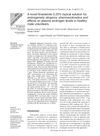Topical Finasteride with Chitosan: an overlooked solution? Finasteride/Dutasteride 8/16/2022
Topical finasteride with hydroxypropyl chitosan shows significantly less serum absorption and minimal DHT reduction compared to oral finasteride. Users need the specific chitosan formulation to avoid side effects seen with regular ethanol+PG solutions.
View this post in the Community →
Similar Community Posts Join
5 / 1000+ resultscommunity My Ultimate Hair Regrowth Regimen: Minimizing Systemic Exposure While Maximizing Results
The regimen includes using a diluted 5.5% Minoxidil / 0.025% Finasteride solution daily, microneedling weekly, and ketoconazole shampoo twice a week to minimize systemic exposure while maximizing scalp DHT reduction. The goal is to achieve hair regrowth with minimal side effects.
community Has anyone ordered JXL-069 (grey market PP405)?
People are discussing JXL-069 (PP405) for hair loss, with some experimenting with a 0.05% topical gel. Concerns about safety and efficacy persist due to limited testing and lack of official approval.
community How come topical finasteride even works at all?
Topical finasteride can effectively reduce scalp DHT by targeting local enzymes, despite less systemic impact compared to oral forms. Combining oral dutasteride with topical finasteride and minoxidil may enhance hair loss prevention, though evidence of its effectiveness is limited.
community What should you look for when buying topical Finasteride?
Topical Finasteride is most effective at 0.1-0.25%, and Minoxidil at 5%. Tretinoin is optional, and additional ingredients like biotin, caffeine, and saw palmetto are recommended.
community Pyrilutamide vs Topical Finasteride
Topical finasteride is currently more effective than pyrilutamide for hair loss. Combining treatments like topical finasteride and pyrilutamide may enhance results due to different mechanisms.
Related Research
6 / 1000+ results
research Proceedings of the Ninth World Congress for Hair Research 2015
The 2015 Hair Research Congress concluded that stem cells, maraviroc, and simvastatin could potentially treat Alopecia Areata, topical minoxidil, finasteride, and steroids could treat Frontal Fibrosing Alopecia, and PTGDR2 antagonists could also treat alopecia. They also found that low-level light therapy could help with hair loss, a robotic device could assist in hair extraction, and nutrition could aid hair growth. They suggested that Alopecia Areata is an inflammatory disorder, not a single disease, indicating a need for personalized treatments.

research 5α-Reductase Inhibitors in Androgenetic Alopecia
Finasteride and dutasteride effectively treat hair loss in men and women, but may cause side effects like low libido and depression.

research Experimental and Early Investigational Drugs for Androgenetic Alopecia
New hair loss treatments may include topical medications, injections, and improved transplant methods.

research A Novel Finasteride 0.25% Topical Solution for Androgenetic Alopecia: Pharmacokinetics and Effects on Plasma Androgen Levels in Healthy Male Volunteers
New finasteride solution effectively reduces baldness-causing hormone, potentially with fewer side effects.

research Efficacy and Safety of Topical Finasteride Spray Solution in the Treatment of Chinese Men with Androgenetic Alopecia: A Phase III, Multicenter, Randomized, Double-Blind, Placebo-Controlled Study
Topical finasteride effectively and safely increases hair growth in men with hair loss.

research Nanotechnology-Based Techniques for Hair Follicle Regeneration
Nanotechnology could improve hair regrowth but faces challenges like complexity and safety concerns.